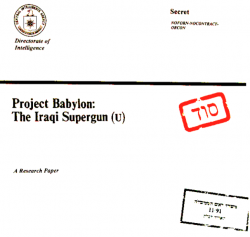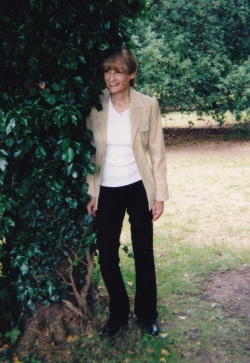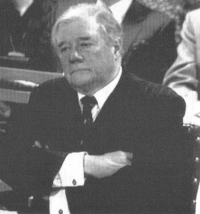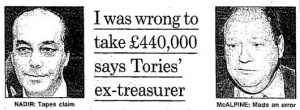Document:Project Babylon and the still smoking Iraqi supergun
| A startling account of the murky dealings of the British political establishment and security services surrounding the legal proceedings agains Asil Nadir |
Subjects: Asil Nadir, Arms-to-Iraq, Gerald James, Gerald Bull, Stephan Adolphus Kock
Source: Tribune Magazine (Link)
Image right: Front page of the unredacted CIA Research Paper SW91-100076X
Wikispooks Comment
The significance of this account is enhanced by the Establishment status of the publication in which it first appeared. It is claimed that its publication "appeared to put the upper echelons of HM Government in a state of panic, for Asil Nadir was moved [from Belmarsh category A prison - Ed] to the Category C Prison Highpoint South, located in the village of Stradishall (near Newmarket) in Suffolk, the next day" [1]
References
- ↑ Asil Nadir is freed – Innocent or not and at what price? - CyprusScene 16 April 2016
★ Start a Discussion about this document
Project Babylon and the still smoking Iraqi supergun
Documents examined during the Old Bailey trial of the tycoon Asil Nadir</big suggest the CIA revealed to the Israeli government that British agents murdered the designer of Saddam Hussein’s supergun.
An “un-redacted” version of a CIA intelligence report on the 1990 shooting of Canadian engineer Gerald Bull was given to Nadir’s defence team, but excluded from his trial.
The report’s cover page is over-stamped in red with the Modern Hebrew word for “secret” and carries the Hebrew text: “From office of prime minister. Date Received 11.91.”
The report names two former British Special Air Service soldiers as the killers of Dr Bull.
A group of Asil Nadir supporters, the Justice for Asil Nadir Committee (JANCOM), says the American Central Intelligence Agency report was excluded from the 2012 trial of Nadir after a dispute between defence barristers during the granting of Public-interest immunity (PII) certificates to exclude politically sensitive documents.
The question was raised last year in the House of Lords by Lord Maginnis of Drumglass. Lord Wallace of Tankerness replied on March 18 2013 for the British Government by refusing to say how many documents had been subjected to PII during the Old Bailey trial in which the former chief of Polly Peck International (PPI) was sentenced to 10 years on August 23 2012, for stealing £29 million from his company and its North Cyprus subsidiary Unipac. Lord Maginnis, formerly Major Ken Maginnis of the Ulster Defence Regiment
The unsolved murder of the artillery expert Gerald Bull, 62, shot dead outside the door of his fifth-floor flat at Uccle, a Brussels suburb, on 22 March 1990, has been variously attributed to the Israeli secret service Mossad, the CIA, or the Iranians.
No one heard the five shots from a silenced 7.65 mm pistol. He was found 10 minutes later. Twenty thousand dollars lay untouched in his briefcase.
Nine days later, Jonathan Moyle, a former RAF helicopter pilot investigating arms dealers in Chile, was found dead in a room at the Hotel Carrera in Santiago. The 28-year old editor of the magazine Defence Helicopter World had been reporting on military sales to Iraq.
Two weeks after the murder of Gerald Bull, British Customs seized eight gun barrel sections, designed by Bull and manufactured by Sheffield Forgemasters, on board the ship Gur Mariner about to leave Teesport for Iraq. The supergun was never built.
The Justice for Asil Nadir Committee say the American document has been verified by a woman known as Olivia Frank.
She now lives in England but admits spying in Germany for the Israeli secret service Mossad in her youth. She says British counter-intelligence MI5 arranged for her to be jailed at the high-security Cookham Wood prison in Kent to conduct negotiations on their behalf with Elizabeth Forsyth, a London private banker born into the McAlpine family who was jailed in 1996 for laundering £400,000 for Nadir but freed on appeal a year later.
Olivia Frank told Tribune:
“On May 10 1993, six days after Asil Nadir left Britain, MI5 approached me once more. Their officer described me as perfect for a so-called deniable operation and offered me a large sum of money as reward if I would agree to meet Mr Nadir in Turkey. MI5 intended to harm him. In order to facilitate false identities, they provided new National Insurance records for me and my partner. An MI6 officer took over the operation when Mr Nadir invited me to meet him in Istanbul. By this time, the investigative reporter Roger Cook had become involved.”
JANCOM has posted two versions of the American document on the world wide web. One version is a report from the CIA Directorate of Intelligence entitled Project Babylon: The Iraqi Supergun, released on the internet under freedom of information rules in the United States but heavily redacted to obscure sensitive passages.
A second un-redacted version produced by JANCOM appears to be the original secret document without any deletions. Certain paragraphs are marked “S NF NC” – a coding that means “secret, not to be seen by foreign nationals or by defence contractors”.
The cover page of the un-redacted document carries two stamps, which suggest it passed though Israeli government hands. There is a red “secret” stamp in Hebrew and a black stamp in Hebrew reading: “From office of prime minister. Date Received 11.91.” If genuine, these stamps indicate that the CIA passed the secret document to Israel in November 1991, just after the government of Yitzhak Shamir agreed under intense pressure from US President George H.W. Bush to attend the Madrid peace conference.
Israel’s first-ever right wing Likud government had been unwilling to attend the post-Gulf War Madrid peace conference, where George H.W. Bush used the goodwill earned by his coalition victory over Saddam Hussein to start a peace process involving Israel, the Palestinians, the Russians and various Arab countries, including Syria, Lebanon, and Jordan.
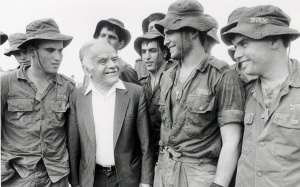
George Bush senior was ex-CIA. Shamir was ex-Mossad. The three-day Middle East conference convened on 30 October 1991. The Israeli government date stamp on the un-redacted report suggests that the CIA had decided to reveal to Israel the secret British and American attempts to foil Saddam Hussein before the First Gulf War.
The successful recapture of Kuwait had involved Syrian tanks fighting alongside the Americans. In January 1991, the US had supplied Patriot missile batteries to protect Israel from Iraqi Scud missile attacks. The November 1991 date stamp suggests the CIA document might even have been passed to the Israelis by hand during the Madrid conference.
Despite the un-redacted document being closely examined and verified before Nadir’s trial by Colonel John Hughes-Wilson, an associate fellow at the Royal United Services Institute and a former member of the Nato international political staff in Brussels, the report was not used to defend Nadir at the Old Bailey.
“The CIA dossier was to form a major part of the defence of Asil Nadir”, according to Olivia Frank.
“I delivered it to Asil’s solicitor Giles Bark-Jones via his partner Fred Bunn, in November 2010 when I met Elizabeth Forsyth, once more, in a London hotel.
“According to Elizabeth, Her Majesty’s Government signed no fewer than 36 PII certificates. This had the effect of censoring numerous Turko-British government letters, so that I believe only one such letter was partially revealed in court and even that was redacted.”
The un-redacted report names several serving and former British secret agents said by the CIA to be involved in a vast Anglo-American arms smuggling operation to supply Saddam Hussein.
These agents include Stephan Adolphus Kock, a former officer in the Rhodesian Special Air Service and consultant to the Midland Bank who was born in Czechoslovakia and died in Scotland at his home at Ellanabeich on the island of Seil near Oban in 2008.
The report states that Sir John (later Lord) Cuckney, a former MI5 officer who also died in 2008, was "the onetime chairman of the state-owned International Military Services (IMS)” who arranged for Stephan Kock to seize control of the British explosives firm Astra, where he “began work concealing Astra’s covert deals via Unipac”.
In an astonishing paragraph on page 25, Christopher Gumbley, chief executive of Astra, is said to have “travelled to Brussels to meet Bull”.
Kock maintained surveillance and discovered that they planned a lawsuit to expose UK covert deals. Consequently, Kock hired [the two ex-SAS men named in the document] to eliminate Bull. Subsequently, MoD police arrested Gumbley. He served nine months in prison on fabricated corruption charges. Meantime, as we co-ordinated an MI6 set-up, alleged nuclear capacitors shipped from US by Euromac for Iraq was [sic] seized at Heathrow Airport, it led to the arrest of CEO Ali Daghir and Jeanine Speckman, Kock found that defence journalist, Jonathan Moyle, possessed evidence of UK covert deals. Consequently, Kock and [a third named agent] eliminated him in Santiago, Chile. [S NF NC].
Kock manipulated Project Babylon to divert media attention from the covert arms deals and tipped off UK Customs. They raided a port in Middlesborough [sic], England, and seized the final supergun consignment of barrel tubes. Kock believed that the media would leap upon the supergun story. As Bull’s project engaged the public imagination, it concealed from them the true extent of UK-approved covert deals. Although Bull had informed the UK about the true purpose of the barrel tubes from the outset, Secretary of State Ridley told Parliament that the UK had only just become aware of Project Babylon. [S NF NC]
As the UK continued to deflect responsibility, Kock arranged the arrest of supergun project manager Cowley and Walter Somers CEO Peter Mitchell, along with several Forgemasters and Walter Somers personnel. UK Customs raided Matrix Churchill, and arrested three executives, while MoD police arrested Ordtec and SRC executives connected to BMARC deals; the (mostly MI6) BMARC executive was protected to avoid exposure. Kock requested the DTI hold a public enquiry into Astra. Subsequently, Kock arranged the arrest of Unipac CEO Asil Nadir via the UK Serious Fraud Office. However, charges against Cowley and Mitchell were dropped for fear of UK deals with Iraqi supergun. As the Conservative Party sought to avoid defeat in the upcoming UK election, they lost confidence in Thatcher and forced her to resign. (S NF NC).
On page 22, the un-redacted version says:
The situation that made Project Babylon feasible began in 1981, as UK Prime Minister Margaret Thatcher sought to grow the British economy through covert arms deals with Iraq, then at war with Iran. In 1982, at the outbreak of the Falklands conflict, Thatcher sought assistance from the US administration and subsequently, we provided intelligence support. Consequently, in 1983, directed by White House strategy, we co-ordinated covert operations with MI6 that eluded Congressional precincts and projected UK rules that sustained arms sales to Iraq via global covert routes established by the UK. In alliance with MI6, we set up Allivane International, at the core of covert deals with Iraq. Its ultimate owner, Chilean arms dealer Carlos Cardoen, received funds from the UK and played a key role.
The un-redacted report describes how a Scottish transport firm shipped a test consignment of Gerald Bull’s supergun propellant disguised as chocolate for re-packaging in Cyprus by Asil Nadir’s subsidiary firm Unipac.
In 1997, the late Lord Harris of Greenwich told the House of Lords that the Serious Fraud Office had found at Polly Peck the stubs of six cheques from the NatWest Jersey account of Unipac, indicating that the company had paid £365,000 to the Conservative Party.
It was Nadir’s failure to account for the movement of cash between London and Northern Cyprus that led to his conviction for theft.
The un-redacted report states:
“The UK pledged Bull funds to buy carbon fibre plant Learfan in Northern Ireland; it formed part of Iraq’s nuclear missiles programme. Pressure from US and Israel reversed the proposition. Bull’s dissent ended when Kock informed him via the UK Foreign Office, that he could meet with an ‘imminent accident’.”
| Two faces of a woman who says she spied for the Mossad, MI5 and MI6 | |
|---|---|
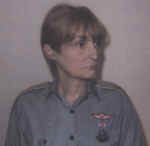 IDF ID card pic |
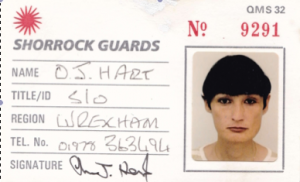 ‘We were given fresh NI and NHS numbers while awaiting assignment for British Intelligence’ |
The CIA document first surfaced in the Turkish newspaper Cumhuriyet. Asil Nadir had sheltered in his native Turkish-controlled Northern Cyprus between 1993 and 2010 as a fugitive from British justice.
In a 2006 online memoir, Naked Spygirl, Olivia Frank describes her childhood in Manchester, the influence of her father, a Jewish soldier wounded at El Alamein, and her recruitment as an agent for Mossad who could travel on a genuine British passport. She says police in Lancashire and Cheshire harassed her parents until she was persuaded by MI5 to commit an accountancy crime and make friends in prison with Elizabeth Forsyth.
She claims to have turned her back on MI5 in prison. After release, Elizabeth Forsyth introduced her to Asil Nadir. Olivia Frank says the un-redacted CIA report is genuine.
JANCOM claims:
“Many documents were deliberately suppressed in court during Asil Nadir’s 2012 trial in London. They would have embarrassed the authorities. They prove that Nadir had been framed by British and American intelligence agencies in a government campaign of dirty tricks, lies, the jailing of innocent men, and even murder, to cover up the fact that both governments had been secretly selling illegal arms to Saddam Hussein using Asil Nadir’s companies.”
At her retirement home in Northern Cyprus, the former private banker Elizabeth Forsyth pointed out that Nadir’s Polly Peck International and Astra, one of the firms involved in supplying explosives to Iraq, had shared the same accountant, Dennis Robertson of Stoy Hayward in Baker Street, London.
I spent 10 months in high security prisons until I won my appeal. I received no compensation for what had happened to me. I won my appeal because Judge Tucker had misled the jury on seven occasions. In reality, it was nine occasions.
During my appeal hearing, one of the three judges, Lord Beldam, asked my QC if Dennis Robertson had been questioned in Asil Nadir’s first trial. Neither he nor I knew to whom he was referring. The judge then directed his question to the Serious Fraud Office who answered very quickly in the affirmative.
Dennis Robertson was the partner in charge of the Polly Peck International audit for Stoy Hayward. Prior to my trial, my solicitor had written to the SFO for a list of the people who had been questioned in AN’s trial. Dennis Robertson’s name was not on that list.
If that statement, which we eventually received after several requests to the SFO, had been given to us, it would have shown that the charge of handling £400,000 had been registered in the audited books of PPI as a genuine back-to-back transaction.
It was some time after my successful appeal that a friend of mine, who had been closely following my trial, mentioned that she had read a book written by Gerald James, the ex-chairman of Astra. In that book, Gerald mentioned that Asil Nadir was in the arms business. I decided to meet Gerald, as I was not aware that this was the case. I ran AN’s personal businesses and I am sure that this suggestion would have appeared somehow or another.
I met Gerald at his club in Piccadilly and he said that if AN was not in the arms business then why were Astra Fireworks sending Unipac, a subsidiary company of PPI, invoices for the manufacture of propellant for the Big Gun? I was completely nonplussed. Gerald then suggested that if this event was unknown to Asil Nadir, and perhaps even to PPI, who then would have been able to open a bank account in PPI’s name?
He asked who PPI’s auditors were and I told him Stoy Hayward. Seemingly, both Astra and PPI accounts were being audited by the same partner in the same firm of accountants, Dennis Robertson. Coincidentally, Dennis Robertson had taken over from a previous auditor on both accounts at the same time, late 1989.
It was therefore possible that in his position as auditor for both companies Robertson could have opened the various accounts for certain military purposes.
When I was able to speak to Asil Nadir again, I asked him whether Dennis Robertson had ever mentioned opening accounts for PPI in Switzerland. He vaguely remembered that this had been the case. Robertson had wanted to open accounts for the three Turkish subsidiaries of PPI in Switzerland for ‘tax reasons’. The companies were Unipac, Meyna and Sunzest.
Dennis Robertson was going to be called as a witness in Mr Nadir’s trial but he died in around 1992. Gerald James is totally convinced that his death was not accidental.
I must make one matter clear. I was instrumental in handing documentation which I had been given during my investigations into this rather lurid business but neither I, nor Mr Nadir’s family, were involved in the construction of the website on which the documents have been published.
Michael Mates MP was a Conservative Northern Ireland minister from 1992 to 1993 until forced to resign after the publication of a letter he had written to the attorney-general in support of Asil Nadir. Mates was a poll tax rebel and a key figure in the removal of Margaret Thatcher. He had given a watch to Nadir engraved ‘Don’t let the buggers get you down’. Mates was a defence witness at Nadir’s 2012 trial and in 2013, when he was running for election as police and crime commissioner in Hampshire, he said of his support for Nadir: "Every single thing that I alleged when I was taking up the case has turned out to be true……I have a clear conscience about it all."
Robin Ramsay, author of Conspiracy Theories and Politics and Paranoia, discussed the validity of the CIA report in the summer 2013 edition of the specialist magazine Lobster:
"In recounting the US-UK (but apparently mostly UK in this account) covert operations to arm Iraq and the subsequent events, it describes four assassinations – Gerald Bull, journalist Jonathan Moyle, Belgian politician André Cools, and one Lionel Jones – commissioned by the late Stephan Kock, allegedly of MI6, and carried out by British (SAS) personnel. This was followed by a vast judicial-state conspiracy to cover it up. But is the document genuine? We will probably never know: the CIA certainly won’t confirm it."
MI6 has in recent years insisted that its officers do not have a licence to kill anyone. The former head of MI6, Sir Richard Dearlove said: “Assassination is no part of the policy of Her Majesty’s Government”, and entirely contrary to the agency ethos.
However, it has been argued that Section 7 of the 1994 Intelligence Services Act might protect a British agent involved in murder abroad. This curious and little-known law was intended to protect British spies from being prosecuted or sued in Britain after committing crimes abroad.
Section 7, offering protection to spies involved in bugging and bribery, might be extended to an agent embroiled in far more serious matters in a foreign country, including murder, kidnap or torture, provided the actions of the agent were authorised in writing by a secretary of state.
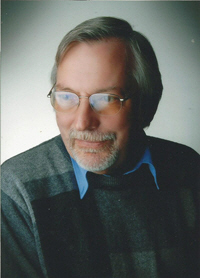
Martin Tancock in Secret Justice: Public Interest Immunity Certificates (PIICs) and their use in the Asil Nadir Trials claims the two trials of Asil Nadir were staged by civil servants in the East European tradition:
“With the rise of Thatcher, and the great show trials of the early nineties: [Euromac]], Ordtec, Matrix Churchill, Elizabeth Forsyth, Asil Nadir; the iron fist of political control has been worthy of anything that has come out of Eastern Europe. In those trials evidence was not properly investigated, it was suppressed, it was manufactured and PII was imposed. Witnesses were not called or barred from attending the trial; allegations of corruption were made without evidence; reporting restrictions were imposed and evidence was heard in secret. Juries were misdirected.”
Wikipedia defines show trial as a pejorative description of a type of highly public trial in which there is a strong connotation that the judicial authorities have already determined the guilt of the defendant. The actual trial has as its only goal to present the accusation and the verdict to the public as an impressive example and as a warning to other would-be dissidents or transgressors. Show trials tend to be retributive rather than correctional justice and also conducted for propagandistic purposes. The term was first recorded in the 1930s.
The three people accusing Britain of staging an East European-style show trial at the Old Bailey – a daughter of the McAlpine family, a former officer in the Ulster Defence Regiment and a former secret agent for the Mossad – have been given no explanation of how 36 Public Interest Immunity certificates could conceivably be lawfully deployed to conceal documents in a mere fraud trial – even if that trial concluded with the long-delayed 2012 conviction of Asil Nadir - a Conservative party donor in the days of Margaret Thatcher.
